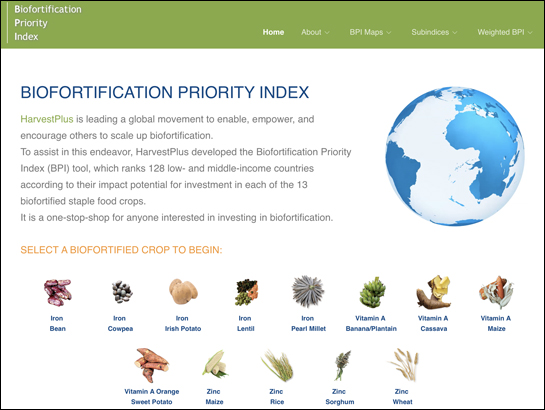What is the Biofortification Priority Index (BPI)?
The BPI is an analytical tool developed by Harvestplus to inform data-driven decisions for scaling up biofortification. It is also recognized as one of the notable innovations of the CGIAR global agricultural research partnership over the past 50 years.
The BPI helps identify where investments in biofortification can have the biggest bang for the buck among 128 countries that the Index covers. The BPI provides rankings of country-level investment potential for 13 types of staple crops.
What is new on the BPI?
The BPI has been upgraded and expanded to include:
- more biofortified crops: iron lentil, cowpea, and Irish potato; vitamin A banana/plantain; and zinc sorghum. They add to the previously available iron bean and pearl millet; vitamin A cassava, maize, and orange sweet potato; and zinc maize, rice, and wheat;
- new releases of biofortified crop varieties available for scaling in the 128 countries,
- new evidence on the nutrition impact of biofortified crops; and
- more functions, including downloadable maps and data.
Who uses the BPI?
Interactive BPI website is a one-stop shop for anyone involved or interested in the development of biofortified varieties and scaling up biofortification. It is of particular use to:
- Crop breeders, to guide research priorities for biofortification breeding;
- NGOs and humanitarian organizations, to identify target locations for programs;
- Private sector actors, to identify profitable investment opportunities for biofortified products (e.g., seed and food);
- International financial institutions and governments, to guide decision-making on the introduction and scaling of biofortified crops.
Watch this video about the updated BPI.
The BPI helps advance biofortification: An impactful innovation
An estimated 3 billion people cannot afford a healthy diet, and six out of the top 10 risk factors for the global burden of disease are diet-related. The effects of the recent COVID-19 pandemic, coupled with the effects of ever-growing climate crises and conflicts, have exacerbated malnutrition, in all its forms, particularly in low- and middle-income countries (LMICs).
One form of malnutrition is micronutrient deficiencies—also known as hidden hunger—which affect an estimated 2 billion people globally; in particular women, adolescent girls, and young children in LMICs who have the highest biological needs for micronutrients but often have the least access to micronutrient dense foods. Widespread deficiencies in key micronutrients such as iron, vitamin A, and zinc are associated with perinatal complications, poor growth, poor cognitive development, and lower intelligence, in addition to increased risk of morbidity and mortality. When left unaddressed, hidden hunger curtails children’s ability to reach their full potential, adults’ productivity, and hence income. This affects countries’ economic development and growth for this generation and generations to come.
Biofortification of key staple crops is proven to be a cost-effective, efficacious, and scalable solution to alleviate hidden hunger. Biofortification uses conventional plant breeding (i.e., non-GMO) methods to develop staple crop varieties that are not only high-yielding and climate-resilient but also dense in key micronutrients crucial for human health: vitamin A, iron, and zinc. Developed with the micronutrient needs (and gaps) of women and children in mind, biofortification targets smallholder farming families in low- and middle-income countries who consume what they produce and cannot access or afford healthy diets or other nutrition interventions.
Staples are consumed by all, regardless of income, social status, gender, or age. This makes biofortification an equitable intervention for increasing micronutrient intakes of all. Biofortification is by no means a silver bullet; it is, however, a golden opportunity for improving the quality of diets delivered by food systems through their backbones, i.e., staple crops.
Under the global leadership of HarvestPlus, as of 2020, almost 400 biofortified varieties of 12 staple crops have been released across 40 countries. Besides several global and regional strategies and policies, 24 target countries have included biofortification in their national policies, regulations, and programs. An estimated total of 9.7 million farming households were growing biofortified crops, translating to nearly 50 million household members consuming biofortified foods.
With a vision to improve the diets of 1 billion people with biofortified staples by 2030, HarvestPlus is leading a global movement to enable, empower, and encourage others to scale up biofortification.
The key pillars to HarvestPlus’ scale-up strategy are
- mainstreaming of micronutrient traits in global and national, public and private staple crop breeding programs;
- integration of biofortification in international financial institutions’ loans and national and regional policies and programs;
- facilitating “biofortification” of seed to food value chains for key staples by crowding in the private sector; and,
- providing a Knowledge Exchange and Technical Assistance Hub on the why, where, and how to of biofortification.
For more information about the Biofortification Priority Index and the work of HarvestPlus, contact us:
[email protected]
